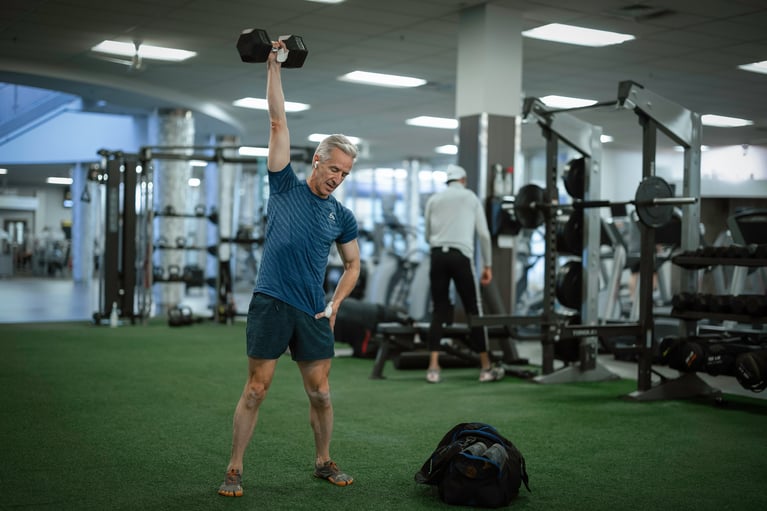
Several months ago my boss approached me and asked if I had room in my schedule for, and would be comfortable training, a new client, a young girl with MS.
As a personal trainer, I’ve carved out a niche working with special populations, individuals with injuries, illnesses, or conditions that require special consideration when designing an exercise program. This could be anything from a knee injury or shoulder surgery to pregnancy, bypass graft, or stroke. I believed that I had enough knowledge of the disease, resources to turn to, and awareness of what adjustments would need to be made in order to train said individual, so I said that I would be happy to meet with the potential client.
Let’s talk, very briefly, about what MS is.
MS, short for multiple sclerosis, is an autoimmune disease in which the individual’s immune system sees the central nervous system (CNS) as a threat. The immune system, therefore, attacks the CNS and causes scarring, or sclerosis, of nerve fibers, hence the name multiple sclerosis.
MS is what’s known as a demyelinating disorder because it specifically targets the myelin sheath of nerve fibers, as well as the cells that produce myelin. Think of the myelin sheath as the rubber coating of a power cord, it channels the signal along the nerve, thus speeding neural transmission, and prevents the signal from jumping randomly to unintended areas. If it is damaged, nerve transmission is slowed or interrupted, causing a myriad of problems.
As a result of this attack on the central nervous system, the individual may experience pain, weaknesses, numbness or tingling, pain, fatigue, and other symptoms. It is an unpredictable disease and the symptoms and prognosis vary greatly between cases.
There is, unfortunately, no cure for multiple sclerosis at this time. Treatment of this disease involves slowing its progression, managing it’s symptoms and maintaining/improving the quality of life.
There are several different types of MS, but the most prevalent is relapsing/remitting. This type of MS is characterized by periods of aggressive attack and onset of symptoms, relapse, and periods of relatively little activity where symptoms may not appear or worsen, remission.
MS is only part of the picture. People with this disease suffer from all of the same maladies as the rest of us, in addition to their disease, and managing everything that is within their power to manage can make a huge difference.
Exercise, crucial for everyone, is especially valuable to individuals with MS because it can help them to do something the rest of us take completely for granted, live a normal life.
When I met Alexa for the first time I had no idea what to expect. I hadn’t been given any more details than “she has MS” I didn’t know if she would be in relapse or remission, how bad her symptoms were, what, if any, disability she might have, or how she was handling her diagnosis.
So when she came walking, almost sauntering, into the gym for the first time and immediately struck up a lively conversation with me, as if we had been friends for years, I forgot, for a time, why she even needed my help. I was, and am, struck by just how full of life she is, and how positive and upbeat she stays. Even if she wasn’t suffering from a difficult disorder she would be an incredible person, but that she remains so in the face of adversity is truly humbling.
It wasn’t until we started our workout that I saw any hint of her MS.
Some of the issues that are often present with MS that are of particular concern to an exercise professional are:
- Rapid onset of fatigue
- Tendency to overheat
- Tight, rigid, muscles
- Weakness
In 15 minutes time, I observed all of this with Alexa. During our very brief warm-up, she turned beet red and needed to sit down between each lap of our training room, an area roughly 50 feet long. I cranked the fans to their highest setting, insisted on frequent breaks, and took it slow.
Even still she struggled a bit with some basic bodyweight exercises, no worse than many perfectly healthy but deconditioned individuals, but more than you would expect just by looking at her if you didn’t know the underlying cause. We finished the day with some stretching and I immediately took note of how tight her muscles were.
I knew that we would have to start slowly and be careful about a few things in order to keep her safe, so I came up with a training plan and we got to work.
The first thing I insisted upon was that she get a heart rate monitor so that I can monitor her exertion during our workouts and prevent her from getting overly fatigued. I’m glad that I did because that has played an enormous role in our training.
During many exercises she shows no sign of fatigue or overexertion, yet as she stands and carries on a normal conversation after a set her heart rate quickly creeps up to close to 100% effort. If she were to sustain such a heart rate for more than a minute or two she would be exhausted, as we learned the hard way before she got the monitor.
Now we are able to track her exertion and allow for adequate rest breaks. Our routine typically consists of supersets of two exercises, one moderate intensity standing exercise such as goblet squats, or deadlifts, paired with a prone or supine exercise like push-ups or dead bugs as “active recovery”.
The standing exercise skyrockets her heart rate, but we do few enough repetitions that it doesn’t stay there long, then as she lays down and begins the active recovery exercise her heart rate stabilizes and begins to return to normal. After each set we allow for full recovery, sometimes several minutes pass between sets.
I have found that this allows her to do relatively high-intensity exercises without putting undue stress on her. She has responded quite well and made tremendous progress.
We also spend a significant amount of time stretching at the end of each session. Individuals with MS often get very stiff, rigid muscles due to something called spasticity. Essentially the disease disrupts the nerve signals to the muscles that control movement and reflex, and the muscles go into spasm. This can be very uncomfortable or painful and if left untreated, debilitating.
Unfortunately, there is nothing I can do that will restore the normal functioning of the nerves, but I can address the tightness of the muscles themselves. Alexa’s muscles, just like anyone else’s, get very tight if they are unused, and the symptoms of MS often make it difficult or painful to be active.
So to combat the natural effects of inactivity and the adaptive shortening that occurs, we spend a significant amount of time doing stretching, particularly PNF, or proprioceptive neuromuscular facilitation, stretches. This type of stretching tricks the muscle into lengthening by overriding the reflexes and is particularly beneficial in this scenario.
In summary, the few modifications that we have made to her program are:
Alexa and I have been training for several months now, and she has made tremendous progress. Aside from the few special considerations I’ve mentioned her training plan looks almost identical to what I would put any other 20-year-old woman through, and she handles it without complaint, cracking jokes the whole time.
When we first started she struggled to sit and stand from a box with just her bodyweight, now she does it holding a 30 lb kettlebell. She didn’t have the stamina to complete more than a 15-minute workout at first, now she goes for a full hour. She does barbell deadlifts, sled pulls, push-ups, modified pull-ups, and farmer’s carries. She can touch her toes and has greater flexibility in her legs than most healthy individuals.
I can’t speak to what effect this has had on her life, but from what I have gleaned from our conversations it seems to me that she is more capable, and certainly more confident, than ever before.
I’ve told you all about Alexa’s training program, but little about her. Allow me to remedy that. She is 20 years old, and she loves to ride horses, shoot guns, fly airplanes, yes actual airplanes, and make people uncomfortable by cracking jokes about her disease. She is funny, outgoing, charismatic, witty, and sarcastic.
She is in school and wants to get a degree in public relations so that she can become a spokesperson for her disease, and help others who might be struggling. She takes charge of her health and researches every recommendation that her doctor’s make, especially related to different drug therapies. She is, wisely, very skeptical of what she puts into her body.
She could, quite fairly, complain about what a bad hand she’s been dealt and wallow in well-deserved self-pity. Instead, she chooses to become a beacon of hope for others out there suffering from the same disease.
Why am I telling you all of this about her? Because if you take nothing else away from what I say today, it is vitally important that you understand that Alexa is not just “girl with MS.” She is a vibrant, passionate, joyful young woman whose immune system just happens to mistake her nervous system for an intruder. She is so much more than her disease, and I want you to remember that.
I am not writing all of this as an instruction manual for exercising with MS. It is a highly unpredictable and variable disease, so each person may have very different needs based on their type, stage, symptoms, etc.
I’m writing this because I want to do what I can to help increase awareness of this disease, share the story of someone special who lives with it, and maybe provide some hope for others out there suffering.
Alexa, and everyone else who lives with M.S., is a normal person who has had some very abnormal challenges thrust upon her. She has been through more in her young life than many of us ever will, and yet she remains positive and is doing her best to live her life to the fullest. Exercise has been a big part of achieving that and has served to give her back some of what her disease has taken from her.
If you, or someone you know, is living with MS I would highly recommend seeking out the help of a knowledgeable exercise professional to help you see how you can fit a workout program into your life. The benefits are many and, if done with care at an appropriate level and under the supervision of a trained professional, the risks are few.
Oh, and if you want to do your part to help end MS you can sign up for Walk MS in Richmond on Saturday, May 4th, 2019 by clicking here. Maybe Alexa and I will see you there!

Join AMFAM United and walk with us to show your support to those affected by MS.

A.S in Exercise Science
B.S Kinesiology, Virginia Commonwealth University
ACSM Certified Personal Trainer
NSCA Certified Strength & Conditioning Specialist
Functional Movement Systems Certified
Certified TRX coach
Damon has been a personal trainer with American Family Fitness since 2014 and has trained a wide variety of clients: youth, seniors, athletes, general population, special populations, etc. He specializes in functional, movement based, training with the goal of restoring and/or improving movement patterns and the ability to carry out activities of daily life. He’s trained clients with adhesive capsulitis, diabetes mellitus, joint injuries, neck and spinal injuries, P.O.T.S., M.S., M.I, stroke, depression, anxiety, and more, with great results.
When not training, Damon is spending time with his wife and two boys ages 3 and 1. On his bucket list: thru-hike the Appalachian Trail, tour Scotland and lift the legendary stones of strength, write a book.
Article contributed by Geraldine Chapman
Geraldine Chapman is the Director of Information Marketing & Social Media at American Family Fitness in Richmond, VA. She’s been in the fitness industry professionally since 1997 as a personal trainer, group fitness manager, and fitness instructor. She has trained and certified in multiple fitness programs over the years. Her favorites to teach are barre, Active®, Blast®, and Power®. Geraldine graduated from Virginia Commonwealth University with a B.A. in Communication Arts & Design. She is also a Certified High-Performance Coach and Applied Neuro Strategist. She is passionate about researching autoimmune diseases and how lifestyle, fitness, nutrition, and mindset play a vital role in the prevention and management of autoimmune issues. When not working, you can find Geraldine with a camera in hand, enjoying quality time with her family and riding her motorcycle around town.








